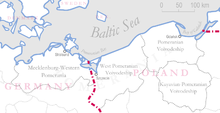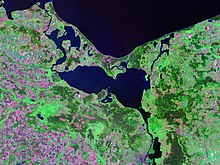Pomerania
![]()
The title of this article is ambiguous. For other meanings, see Pomerania (disambiguation).
Pomerania is a region in northeastern Germany and northwestern Poland, extending inland from the Baltic Sea coast and its offshore islands from just under 50 km to almost 200 km. The name Pomerania is the Germanized form of a Slavic landscape name derived from a Slavic phrase meaning "by the sea" - cf. po morzu "by the sea, along the sea" or po morze "to the sea" in Polish. The western boundary is the Recknitz. There are differences between the German and Polish linguistic usage about the perception regarding the extension to the east.
In German usage, Pomerania refers to the area of the former duchy and later Prussian province of Pomerania. The province of Pomerania lay within the German state borders of 1937 and existed as such from 1815 until the end of the Second World War. The area is composed of Vorpommern, which lies west of the Oder River, and Hinterpommern, which lies east of the Oder River. The landscape to the east of Hinterpommern up to the Vistula is called Pommerellen, which means "Little Pomerania".
In Polish, the name Pomerelia does not exist. In the Polish understanding Pomerelia, also called Danzig Pomerania, forms the core of Pomerania. The historical Pomesania on the eastern bank of the lower Vistula is also included. The area of the former Griffin Duchy and thus of the former Prussian province of Pomerania is called West Pomerania in Polish or also Stettiner Pomerania. The Polish name Przedpomorze for Western Pomerania corresponds to the German one, although this part of Pomerania is the most distant from central Poland. Sometimes one also speaks of the so-called Middle Pomerania (Pomorze Środkowe) with Koszalin and Słupsk as the main centres.

Today's administrative units that bear the name component Pomerania: In Germany Mecklenburg-Vorpommern, in Poland the West Pomeranian Voivodeship, the Kujawsko-Pomeranian Voivodeship and the Pomeranian Voivodeship.
Geography
Politically, Pomerania today is divided between the German states of Mecklenburg-Vorpommern and Brandenburg and the Polish voivodeships of West Pomerania with its capital Szczecin, Pomerania with its capital Gdańsk, and Kujawsko-Pomerania with its capitals Bydgoszcz and Toruń.
The Pomeranian Bay and the Szczecin Lagoon, also known as the Oder Lagoon, lie in the region. The largest islands off the Pomeranian coast are Usedom, Wollin (Wolin) and Rügen. The islands of Rügen and Usedom and the Bodden coast of Western Pomerania have a mixture of land cores with a close interlocking of land and sea and spits connecting them (not so called here). The inland of Western Pomerania is characterised by a network of glacial valleys, the bottom of which is only slightly above sea level. Since the Stettiner Haff (Oderhaff) is a sea bay, the three estuary arms of the Oder, i.e. Peenestrom, Swine (Świna) and Dievenow (Dziwna) are not rivers but sea arms. Between Dievenow and Gdansk Bay (Zatoka Gdańska) extends the Pomeranian Compensatory Coast. There, the bays have been closed by currents and now form beach lakes, such as Lake Leba. At the end of the Equalizing Coast, the Hela Peninsula (Polish: Hel) juts into the Bay of Gdansk. The Pomeranian Lake District, formed during the Ice Age, stretches inland from Hinterpommern and Pomerania, the eastern part of which is also called the Kashubian Lake District. The strip between the coast and the lake district is called the Pobrzeże Slowińskie.
Most of Vorpommern lies in the state of Mecklenburg-Vorpommern with the main centres of Stralsund and Greifswald. The southernmost part of Vorpommern lies in the state of Brandenburg and extends south to the Randow and Welse rivers. Most of the communities of Vorpommern in Brandenburg are grouped together in the Amt Gartz (Oder). The villages of Schönow and Jamikow in West Pomerania belong to the municipality of Passow in the Amt Oder-Welse. The Vorpommern villages of Kunow and Kummerow are part of the town of Schwedt/Oder. Part of Western Pomerania, the so-called Stettiner Zipfel with the city of Szczecin itself as well as the easternmost section of the island of Usedom (Uznam) with the former district town of Swinemünde (Świnoujście) and the island of Wollin (Wolin), belongs to the Polish voivodeship of Western Pomerania.

Beach of Ahrenshoop (peninsula Darß) in Western Pomerania

Satellite image of the Oder estuary with Stettiner Haff, Peene, Peenestrom, Usedom, Swine, Wollin, Dievenow and Pomeranian Bay.
Origin and meaning of the name
The name is derived from the Slavic po more and means "by the sea". Pomerania is originally the land of the Slavic tribe of the Pomorans.
The Latin name Pomerania is written down as the phrase longum mare ('along the sea') in the Dagome Iudex document of c. 1086, a registry of the Curia concerning a donation to the pope made around 990 by "Dagome and Ote" (Mieszko I and Oda of Haldensleben), describing their land as "Schinesge" (early Polish Piast state). The Spanish-Arab-Jewish traveller Ibrahim ibn Jaqub visited - also in the 2nd half of the 10th century - the trading town of Vineta near the mouth of the Oder, which has not been located with certainty to this day, and also mentioned Demmin and the pre-Pomeranian tribe of the Ranen. The first mention of Pomerania is found for the year 1046 about a Zemuzil, Duke of Pomerania ("Zemuzil [dux] Bomeraniorum"). Pomerania is frequently mentioned in the chronicles of Adam of Bremen around 1070 and Gallus Anonymus around 1113.
Search within the encyclopedia